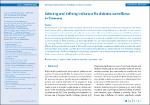Selecting and defining indicators for diabetes surveillance in Germany
Gabrys, Lars
Heidemann, Christin
Baumert, Jens
Teti, Andrea
Du, Yong
Paprott, Rebecca
Ziese, Thomas
Banzer, Winfried
Böhme, Michael
Borrmann, Brigitte
Busse, Reinhard
Freitag, Michael
Hagen, Bernd
Holl, Reinhard
Icks, Andreas
Kaltheuner, Matthias
Koch, Klaus
Kümmel, Stefanie
Kuhn, Joseph
Kuß, Oliver
Laux, Gunter
Schubert, Ingrid
Szecsenyi, Joachim
Uebel, Til
Zahn, Daniela
Scheidt-Nave, Christa
Mainly because of the large number of people affected and associated significant health policy implications, the Robert
Koch Institute (RKI) is developing a public health surveillance system using diabetes as an example. In a first step to
ensure long-term and comparable data collection and establish efficient surveillance structures, the RKI has defined a
set of relevant indicators for diabetes surveillance. An extensive review of the available literature followed by a structured
process of consensus provided the basis for a harmonised set of 30 core and 10 supplementary indicators. They correspond
to the following four fields of activity: (1) reducing diabetes risk, (2) improving diabetes early detection and treatment,
(3) reducing diabetes complications, (4) reducing the disease burden and overall costs of the disease. In future, in
addition to the primary data provided by RKI health monitoring diabetes surveillance needs to also consider the results
from secondary data sources. Currently, barriers to accessing this data remain, which will have to be overcome, and gaps
in the data closed. The RKI intentends to continuously update this set of indicators and at some point apply it also to
further chronic diseases with high public health relevance.
Files in this item

